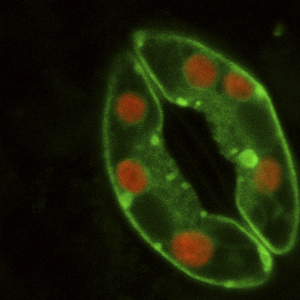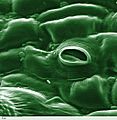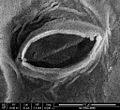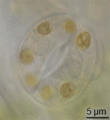Stomata facts for kids
Imagine tiny mouths on a plant's leaves – those are stomata (say: STOH-mah-tuh). A single one is called a stoma. These are tiny openings or pores, mostly found on the underside of plant leaves. You can also find them on stems and other green parts of a plant. Almost every plant on land has them!
Stomata are super important because they help plants "breathe" and control water. They let gases move in and out of the plant, and they also help the plant release water vapor.
What Stomata Do
Stomata have two main jobs that are vital for a plant's life:
Gas Exchange
One of the main jobs of stomata is to let gases in and out of the plant.
- Plants take in carbon dioxide from the air through these tiny openings. They use this carbon dioxide to make their own food in a process called photosynthesis.
- During photosynthesis, plants produce oxygen. Some of this oxygen is used by the plant for its own energy, in a process called respiration. Any extra oxygen leaves the plant through the same stomata.
Transpiration
The second big job of stomata is called transpiration. This is like sweating for plants!
- Water vapor (water in gas form) leaves the plant through these pores and goes into the atmosphere.
- Transpiration helps pull water up from the roots to the rest of the plant, like a tiny drinking straw. It also helps cool the plant down, just like sweating cools you down.
How Stomata Work
Each stoma is surrounded by two special cells called guard cells. These guard cells act like tiny doors, opening and closing the stoma.
- When the plant needs to take in carbon dioxide or release water, the guard cells swell up with water. This makes them bend outwards, which opens the stoma.
- When the plant needs to save water, like on a hot, dry day, the guard cells lose water. They become floppy and close the stoma, preventing too much water from escaping.
This clever system helps plants control how much water they lose and how much carbon dioxide they take in, depending on the weather and their needs.
Images for kids
-
A stoma in a tomato leaf, shown with special colors from a scanning electron microscope image.
See also
 In Spanish: Estoma para niños
In Spanish: Estoma para niños







